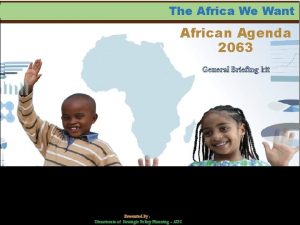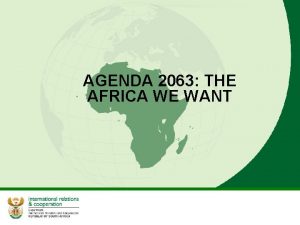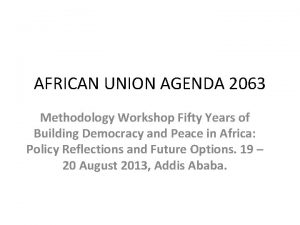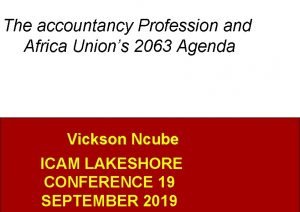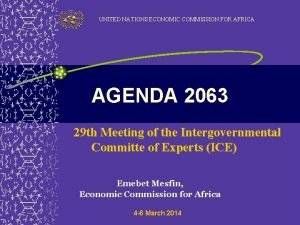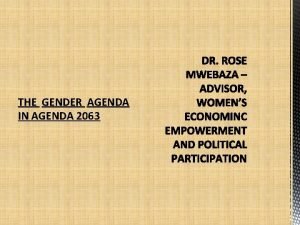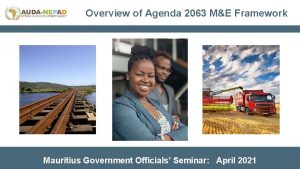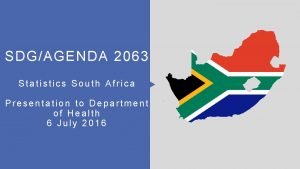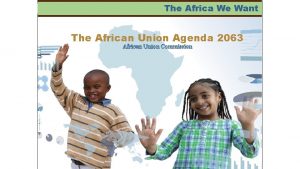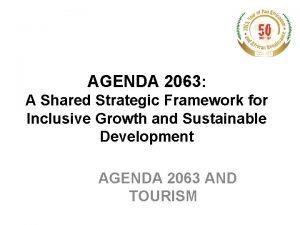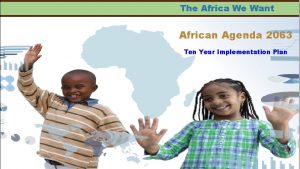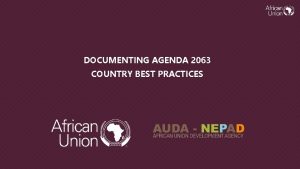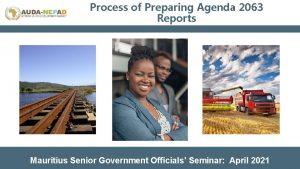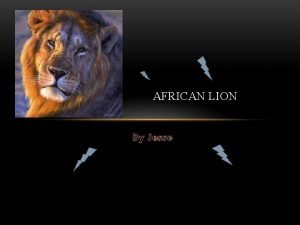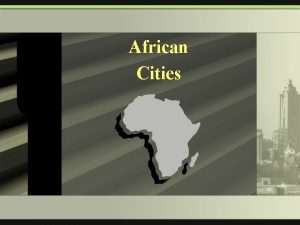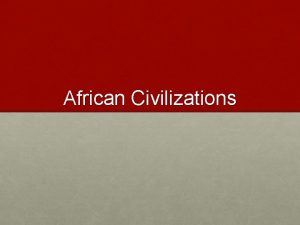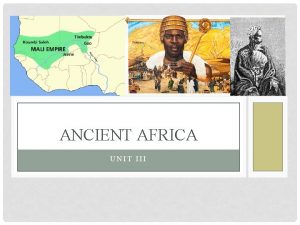The Africa We Want African Agenda 2063 Overview
































- Slides: 32

The Africa We Want African Agenda 2063 Overview of the First Ten Year Implementation Plan Presented By : SPPMERM/AUC Directorate of Strategic Policy Planning - AUC

Outline of the Presentation • Expectations • Validation Processes • The First Ten Year Implementation Plan • The Way Forward

Expectations • General appreciation of the First Ten Year Plan • Understanding of the nature, scope and structure of the Results Framework of the First Ten Year Plan • Laying foundation for the domestication of the 10 -year plan

Validation Process • Drawing upon Agenda 2063 Framework Document • Drawing upon AU Assembly Decisions and existing initiatives at continental and regional levels with plan period • Sector Experts meeting: six sectors • Director General’s Of Planning / Senior Planning Experts in Government (Over 45 countries were present) – 96 participants • Ministers of Finance; Planning and Integration / Technical Staff (STC) • AU Policy Organs – Executive Council Ministerial Retreat on Agenda 2063 in June 2015 in Johannesburg • Adoption by the AU Summit in June 2015 in Johannesburg

Outline of the First Ten Year Implementation Plan Document • • The Structure of First Ten Year Plan Document Goals and Priority Areas for The First Ten Years The Plan Framework Making It Happen Monitoring and Evaluation Financing the Plan Partnerships Annexes 1 -6 • Policy Guidelines on Implementation Monitoring and Evaluation • The First Ten Year Plan: Implementation Timeline • AU Agenda 2063 and African Common Position on Post 2015 Development Agenda: Commonality Profile • Profile of Flagship Projects/Programmes • Critical Success Factors, Potential Risks and Mitigation Strategies • Funding Needs and Potential Sources of Funding

Structure of the First Ten Year Plan Document 1. Introduction: Covers the context, purpose and foundation and preparation process. It situates the plan within the context of Agenda 2063 and highlights its foundations as the AU Vision, The AU 50 th Anniversary Solemn Declaration and the Seven African Aspirations with the purpose for its preparation as to providing a common results framework for Africa’s socio-economic transformation within the first ten years of the 50 year horizon. 2. Goals and Priority Areas: Looks at the current development situation in the seven aspirational areas and provides the selection criteria for Goals and Priority Areas which form the basis for the plan framework; lastly it provides a snap shot of Africa in 2023 when all the set goals and targets have been attained. 3. Plan Framework: It outlines for each of the 7 aspirations - the goals, the priority areas for each goal, the target(s) for 2023 (national, regional and continental) ,

4. Implementation Plan: It presents the principles (eg diversity, subsidiarity, inclusiveness, results orientation, leveraging of existing institutions) which will guide all stakeholders in the implementation of the Ten Year Plan, the key stakeholders – national/sub-national, RECs and AUC, PAP, ECA, Af. DB etc are identified and their roles indicated; timelines, policy guidelines for execution of key implementation activities and issues related to capacity and communication are presented 5. Monitoring and Evaluation: It outlines the rationale for an M&E, structure of results framework, policy guidelines on M&E and knowledge and experience sharing required for the successful execution of the ten year plan 6. Financing: It identifies the financing need of the First Ten Years together with the facilitative measures that will ensure funds availability; it also presents the implementation arrangements which will ensure funds availability 7. Partnerships: It outlines the recommendations on partnerships with respect to having

Structure of the Results Framework

Goals and Priority Areas- 20 Goals (Truncated Example) Aspiration (1) Prosperous Africa, based on Inclusive Growth and Sustainable Development Goals A High Standard of Living, Quality of Life and Well Being for all Citizens Well Educated Citizens and Skills Revolution underpinned by Science, Technology Priority Areas Incomes and Jobs Poverty and Hunger Social Security and protection, including Persons with Disabilities Modern, Affordable and Livable Habitats and Quality Basic Services Education and STI driven Skills Revolution

Aspiration (1) Goals Priority Areas Healthy and Well Nourished Citizens Health and Nutrition Transformed Economies Sustainable and Inclusive Economic Growth STI driven Manufacturing, Industrialization and Value Addition Economic Diversification and Resilience

Aspiration (1) Goals Priority Areas Modern Agriculture for Agricultural increased Production and Productivity and Blue/Ocean Economy Marine resources for accelerated industry economic growth Port Operations and Marine Transport Marine Energy and mining

Aspiration (1) Goals Priority Areas Environmentally Sustainable sustainable and climate Consumption resilient Economies and Patterns Communities Biodiversity conservation and Sustainable Natural Resource Management Water Security Climate Resilience and Natural Disasters Renewable Energy

Aspiration (2) An Integrated Continent, Politically United, based on the ideas of Pan Africanism and the Vision of Africa’s Renaissance Goals Priority Areas A United Africa (Federal Frameworks and or Confederate) Institutions for a United Africa Continental Financial and Monetary Institutions established and Functional World Class Communications and Infrastructure Crisscrosses Africa Connectivity; Liberalization of air transport and full implementation of Yamoussoukro Decision Intra-African Trade

Aspiration (3) Goals Africa of Good Democratic Values, Governance, practices, universal Democracy, principles of Human Respect for Human rights, Justice and Rule of Law Entrenched Capable Institutions and Transformative Leadership in Place Priority Areas Democracy and Good Governance Human rights, Justice and Rule of Law Institutions and Leadership Participatory Development and Local Governance

Aspiration (6) Goals An Africa whose Full gender Equality Development is in all Spheres of Life people-driven, especially relying on the Potential offered by its Women and Youth, and well cared Engaged and for Children empowered Youth and Children Priority Areas Women and Girls Empowerment Sexual Violence and discrimination Youth Empowerment and Children’s Rights

The Plan Framework comprises the following: Criteria for Selecting Goals, Priority Areas and Targets from the Agenda 2063 Framework Document for the first ten year plan Highlights of Major Initiatives (Fast Track Projects / Programmes) Plan Results Framework Matrices by Aspiration Key Success strategies Factors, risks and mitigation

Criteria for Selecting Goals, Priority Areas and Targets from the 50 year technical document for the first ten year plan Fast Track Projects / Programmes Focus areas in national/regional plans Continental frameworks (eg. CAADP, PIDA, AMV) Assembly Decisions ( eg. Silence All Guns by 2020)

Fast Track Projects / Programmes Integrated High Speed Train Network Africa Virtual and E-University African Commodity Strategy Annual African Forum Continental Free Trade Area African Passport and free movement of people Grand Inga Dam Project Pan African E-Network Silencing the Guns African Outer Space Strategy Continental Financial Institutions

Highlights of a few other programmes / initiatives/ results for 2023 Inclusive economic growth with expanded job opprtunities, especially for the youth and women Emergence of agro /commodity value addition manufacturing enterprises Doubling productivity in agriculture and the banishment of the hand held hoe Expanded early childhood education and compulsory secondary education Steep reductions in incidence of malnutrition, maternal, child and neo-natal deaths plus universal access to Anti Retroviral drugs for those afflicted by HIV/AIDs

• Expanded and improved access to the basic necessities of life: water, sanitation, electricity, transport and internet connectivity • Entrenched democratic practices, human rights and the rule of law • Completion of the Encyclopedia Africana • Complete women’s empowerment in all spheres of social, economic and political lives • Expanded opportunities for the youth in the creation of new businesses • Eradication of child labor exploitation, marriage, trafficking and soldiering • Deepened financial / capital markets- The African Investment

Plan Results Framework Matrix-Truncated Example Aspiration 1: A Prosperous Africa Based On Inclusive Growth and Sustainable Development Goal 5: Modern Agriculture for increased productivity and production Priority Area (1) 2023 Target Key Process Actions/ Milestones Towards 2023 on AU Frameworks Agricultural Production and Productivity National § Double total factor productivity § Reduce post-harvest loses by 50% National § National Agricultural Plans (NAIPS) aligned to Malabo Targets by 2017 Regional § Consultations with Member States on aligning of NAIPS to Malabo Targets is done in 2017 Indicative Strategies

Success Factors/ Risks and Mitigation Strategies Key Success Factors Risks • Leadership and Political Commitment • Conflict, Instability and • Capable Development State Insecurity • Participation, Inclusion and • Failure to harness the Empowerment & Engagement by demographic dividend Citizens • Climate Resilience and Natural • Results Orientation Disasters • External Shocks • Management of Diversity Mitigation Strategies have been addressed through the: Results Matrix- diversification to minimize external shocks, creation of capable states as priority area, prevention of conflicts/maintenance of peace and security as goals/priority areas, managing diversity at national level through targets for inclusiveness/ management of ethnicity etc, at the continental level through the setting of goals / targets( land locked states, island states and targets that are nation dependent - reduce poverty by X% Implementation arrangements: Assignment of responsibilities and accountabilities plus monitoring mechanisms on all stakeholders; participation of citizens in the processes,

Making It Happen Principles • Subsidiarity • Accountability and Transparency • Participation, Inclusiveness and Integration • Diversity • Leveraging on Existing Institutions and Systems • Harmonization of Policies, Systems and Practices Stakeholder Relationships • Continental • Regional • National All Stakeholders Activities are linked through TIME LINES

Responsibilities/Accountabilities (In Policy Guidelines) Each of the Stakeholders has been assigned some responsibilities. For example, in the case of the RECs on • At inception provides leadership in the Regional / National implementation: • • • Consultative Process with respect to the preparation of Agenda 2063 Participates in the continental operational oversight of Agenda 2063 and be the entry point for continental level initiatives for Member States in the region. Adapts / aligns continental long /medium term Agenda 2063 10 Year Plans / Guidelines to regional plans Issues regional Agenda 2063 10 Year Plan guidelines to Member States Coordinates the preparation and execution of regional projects / programmes as per Agenda 2063 Coordinates the integration of Monitoring and Evaluation reports of Member States in the region and submit to the Ministerial Committee for their consideration

Capacities for Making It Happen • All Stakeholders (individuals and institutions) in the implementation, monitoring and evaluation chain at the continental, regional and national levels will be capacitated • At the individual level focus will on: leadership and transformational skills, behavioral / attitudinal change • At the institutional level focus will be on: planning, monitoring and evaluation, systems and process improvements and information technology upgrades • Consultancy for the Study on Capacity assessment first for AU Organs and RECs is taking place

Communications • A communication strategy has been developed • The objective of the Com. Stra is to engage the African Citizenry and Institutions for ideas generation/sharing, participation in periodic development/ revision of the results framework, participation in the monitoring and evaluation and more importantly their owning both the processes and the outcomes of Agenda 2063 • The main communication tools at the national, regional and continental levels envisaged include: meetings; debates; community / town hall/church or mosque meetings; workshops, songs, poems, teaching in schools, TV and radio presentations/discussions amongst others

Monitoring and Evaluation (Policy Guidelines) Each of the Stakeholders has been assigned responsibilities in monitoring and evaluation. For example for RECs: • Designate a focal point within its structures to be responsible for the coordination / facilitation of M&E of the implementation of Agenda 2063 by Member States and Regional Agenda 2063 Programmes. • Issue Regional specific Agenda 2063 monitoring and evaluation guidelines to member states. • Organize annual fora for Member States to review regional monitoring and evaluation performance on Agenda 2063.

Financing The Plan • A Resource Mobilization Strategy Study has been completed • Key areas requiring financing at the national, regional and continental levels have been identified by aspiration and potential sources for funding identified. • These potential sources embrace: (1) Existing vehicles (DFI, Banks, MFI, Stock Exchanges, etc. ) (2) current AU initiatives such as : Illicit capital outflows, High Level Panel on Alternative Sources of funding, ACGA, IPDF, AIB, Bonds ( Infrastructural, Diaspora), African Credit Guarantee Facility etc…. . (3) Af. DB Africa 50 Fund.

Financing The Plan Key Strategies For The RM are: Three Main Sources ØDomestic Resource Mobilization (75%)– Fiscal Resource, Resource Rents, Savings & Capital Mkt, IFF /Corruption/Wastage ØODA, FDI, PPP, Remittances (15%) – Maximizing their quality and leveraging to further access Commercial Finance ØInternational Financial Market (10%)– Maximizing access at better terms Three-level strategies: (1) Mobilization of Resources, (2) Intermediation Vehicles (both existing & new), (3) A 2 F Facilitation (Project Development Fund, Risksharing Facilities, Business Development Facilities) Enablers & Facilitative Measures: (1) Growth & trade performance, (2) Policies for improving investment climate, (3) Developing expertise in financial advisory services, (4)

Partnerships • The following actions are to be undertaken to maximize benefits from AU Partnership relations: Ø Preparation of AU Policy Framework on Partnership Ø Developing / implementing strategies for partnership benefits maximization Ø Deepening partnerships transformational benefits from

The Way Forward • Domestication process at national, regional and continental levels, including popularization measures; • Engagement with specialized sectors, civil society private sector; • Institutional alignment and capacity strengthening

THANK YOU
 Agenda scenario
Agenda scenario Agenda sistemica y agenda institucional
Agenda sistemica y agenda institucional Sự nuôi và dạy con của hổ
Sự nuôi và dạy con của hổ Các châu lục và đại dương trên thế giới
Các châu lục và đại dương trên thế giới Dot
Dot Bổ thể
Bổ thể Thế nào là sự mỏi cơ
Thế nào là sự mỏi cơ độ dài liên kết
độ dài liên kết Thiếu nhi thế giới liên hoan
Thiếu nhi thế giới liên hoan Vẽ hình chiếu vuông góc của vật thể sau
Vẽ hình chiếu vuông góc của vật thể sau Bài hát chúa yêu trần thế alleluia
Bài hát chúa yêu trần thế alleluia điện thế nghỉ
điện thế nghỉ Một số thể thơ truyền thống
Một số thể thơ truyền thống Sơ đồ cơ thể người
Sơ đồ cơ thể người Công thức tính độ biến thiên đông lượng
Công thức tính độ biến thiên đông lượng Số.nguyên tố
Số.nguyên tố đặc điểm cơ thể của người tối cổ
đặc điểm cơ thể của người tối cổ Tỉ lệ cơ thể trẻ em
Tỉ lệ cơ thể trẻ em Các châu lục và đại dương trên thế giới
Các châu lục và đại dương trên thế giới ưu thế lai là gì
ưu thế lai là gì Thẻ vin
Thẻ vin Các môn thể thao bắt đầu bằng tiếng đua
Các môn thể thao bắt đầu bằng tiếng đua Tư thế ngồi viết
Tư thế ngồi viết Cái miệng xinh xinh thế chỉ nói điều hay thôi
Cái miệng xinh xinh thế chỉ nói điều hay thôi Hát kết hợp bộ gõ cơ thể
Hát kết hợp bộ gõ cơ thể Từ ngữ thể hiện lòng nhân hậu
Từ ngữ thể hiện lòng nhân hậu Trời xanh đây là của chúng ta thể thơ
Trời xanh đây là của chúng ta thể thơ Tư thế ngồi viết
Tư thế ngồi viết Giọng cùng tên là
Giọng cùng tên là Gấu đi như thế nào
Gấu đi như thế nào Thể thơ truyền thống
Thể thơ truyền thống Sự nuôi và dạy con của hươu
Sự nuôi và dạy con của hươu Diễn thế sinh thái là
Diễn thế sinh thái là
